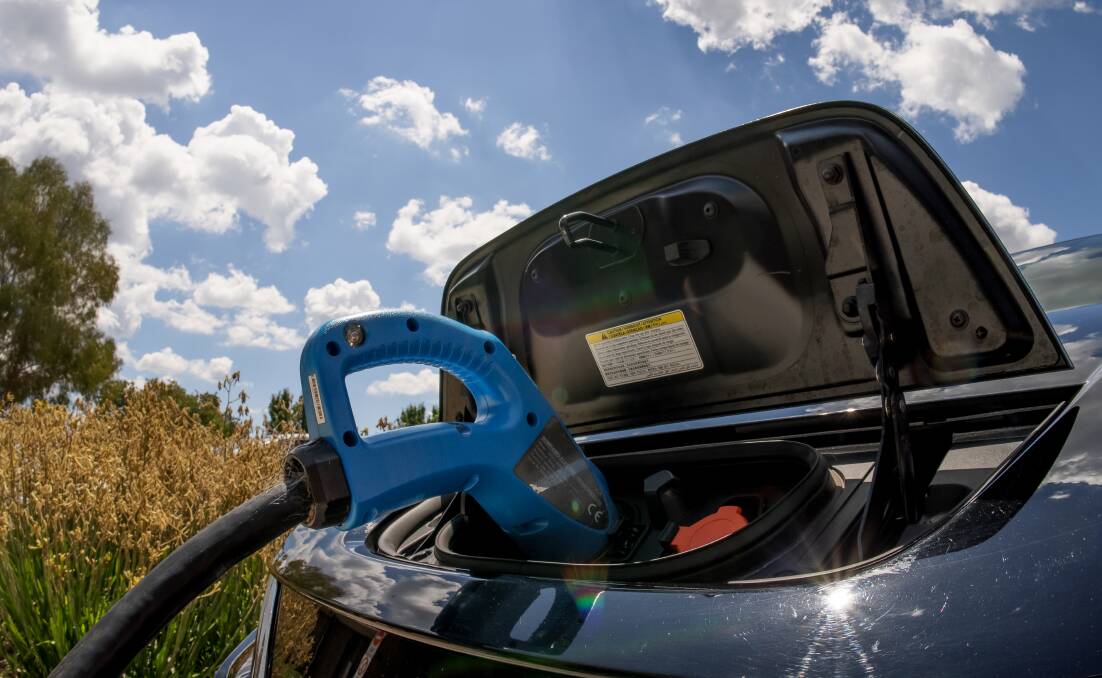The firefighters' union says members have a "training mountain to climb" to fully understand the hazards posed by crashed electric and hydrogen vehicles as the ACT government pushes ahead with fresh incentives to encourage zero-emissions vehicle ownership.
While electric and hybrid cars currently represent less than 1 per cent of the market, the ACT government aims to drive the shift harder than any other jurisdiction with incentives such as two years' free registration, which came into effect Monday.
Nissan, which builds the world's best-selling production electric vehicle (EV), doesn't mince words when describing the gravity of the danger its car poses to first responders, advising that "failure to properly shut down the high-voltage system before the emergency response procedures are performed will result in serious injury or death from electrical shock".
"There is a challenge ahead to ensure fire and rescue personnel are given the training and tools they stay ahead of this technology shift," ACT firefighters' branch secretary Greg McConville said.
"We need to systematically improve the validity of our members' skills."
The ACT Emergency Safety Agency's head of fire safety, Matt Shonk, describes the rescue response to crashes involving electric and hydrogen cars as "an evolving space".
"With all these new technology drive systems, whether it's hybrid or electric or hydrogen, each of those has different hazards," Superintendent Shonk said.

Electric vehicles need to have their battery packs isolated after a crash. Picture Sitthixay Ditthavong
"Operational crews receive the parameters that will keep them safe at EV fires, regardless of the actual model of vehicle that's involved and most of those revolve around exclusion zones and methods of extinguishment and what phase you are at in that incident."
One of the tech tools growing in use is the online rescue app, developed by national vehicle crash safety authority ANCAP, which a rescue officer can study on the way to a collision, looking for the bright orange lines which reveal where the power is routed through the chassis.
Impact sensors and ground fault detectors in most modern vehicles should, in theory, isolate high voltage battery systems in major crashes however, the technology is far from perfect. And dozens of new EV models will arrive in the next few years, mostly from China, as the rush to have the cars certified and for sale turns to a flood.
READ MORE:
Some of the latest premium electric vehicles, such as the Porsche Taycan sports car, have onboard battery packs generating up to 800 volts and without the right advice, present as a potential minefield for rescue workers approaching a crashed vehicle with a set of hydraulically-powered "jaws of life".
Popular US EV maker Tesla has what's known as a "first responder loop" on its vehicles which acts as an isolator and must be cut to isolate the high-voltage battery system and the airbag triggering system.
Access to the loop is behind a panel under the bonnet of the car (or the front trunk, as it's known in the US).
"Cutting of the first responder loop also removes 12-volt power going to the high voltage contactors inside the high voltage battery pack," the guide says.
Other EV models, like the Nissan Leaf, identifies eight high-voltage components on board and there are four different ways to isolate the main 420-volt battery pack.
For rescue workers rushing to save someone's life, there are further complications. As Nissan states in its official rescue guide: "after the high-voltage system is shut down, please wait at least 10 minutes for complete discharge of the high-voltage capacitor".
Most car brands and models are listed on the ANCAP app, which reveals in colour codes where the potential hazards are located in a vehicle. High voltage conduits from the batteries to the motors are one hazard but there are plenty of others including airbag inflators and pyrotechnic seatbelt pre-tensioners.
All modern EVs predominantly use large lithium-ion battery systems. Battery fires burn in a very different way to petrol fires, often as a result of what's known as "thermal runaway", which is less volatile than petrol but can emit significant amounts of noxious gases.
Per capita, the The ACT is the fastest-growing electric vehicle market in Australia with the government pushing for its its fleet to completely transition to zero emissions within the next 12-18 months. While not all directorates are on board with the government's goals, there are currently 140 zero-emission vehicles on the ACT fleet, including the nation's largest fleet of hydrogen fuel cell vehicles.
Our journalists work hard to provide local, up-to-date news to the community. This is how you can continue to access our trusted content:
https://news.google.com/__i/rss/rd/articles/CBMib2h0dHBzOi8vd3d3LmNhbmJlcnJhdGltZXMuY29tLmF1L3N0b3J5LzcyNjY5NTIvY2hhbGxlbmdlcy1wb3NlZC1mb3ItcmVzY3VlcnMtaW4tcmFwaWQtZWxlY3RyaWMtdmVoaWNsZS11cHNoaWZ0L9IBAA?oc=5
2021-05-24 14:00:00Z
52781615478923
Bagikan Berita Ini














0 Response to "Crashed electric and hydrogen cars pose a unique set of dangers to first responders - The Canberra Times"
Post a Comment